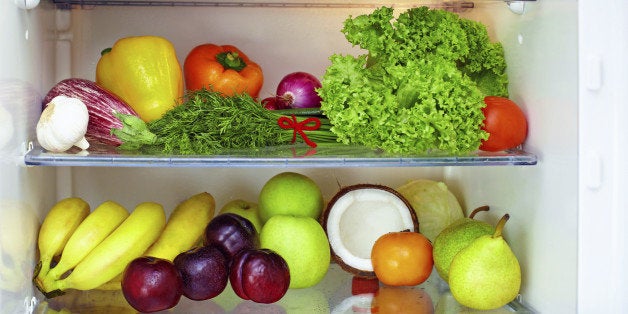
By: Rise Coach, Jo Bartell, MS, RD, CDN. Rise is a nutrition app that connects you with a top registered dietitian for daily coaching and accountability.
Before you even start to think about revamping your personal style in the kitchen, you can give yourself a pat on the back. This video showed us what 2,000 calories looks like, making it clear that if you're cooking at home you're taking those calories way further than anything that's made for you in a restaurant or frozen meal.
So, you're already most of the way there, but you can do yourself (and your family) one better with these simple substitutions that will slim down your everyday meals. And don't worry: none of these substitutions will scare off the kids either; you can make healthy swaps that they'll never notice.
1) Skip the Oil: Steam or Boil Veggies
Asparagus is ready to eat after just two minutes in boiling water. Kale and spinach wilt to perfection in the blink of an eye. Not only are steaming and boiling faster ways to cook, but they cut down on prep (no need to stir) and clean up (rinse and dry). Best of all, because these methods need no added fat in cooking, the result is a much lower-calorie veggie dish. The only risk you run is the water draining flavor. Steaming beats boiling for nutrient retention, because floating in water leaches out nutrients. To avoid bland boiled veggies, bring the water to a full boil and then throw in a little bit of salt before you add them. If the vegetables are green, you want to decrease cooking time, so use extra water to keep the temperature as high as possible. For other veggies, barely submerge them, using just enough water to spread the heat.
If you want to add a little bit of oil after steaming, go for it -- or try browning 1 tablespoon of butter to drizzle over the vegetables. Adding a small amount of oil or butter at the last minute will will add to flavor and help you absorb the fat soluble vitamins A, D, E, K from the rest of the meal.
2) Use Plain Greek Yogurt for... Everything
Greek yogurt has all the probiotics and vitamins and minerals (including calcium, potassium, zinc, B6, B12) of standard yogurt plus double the protein and a creamy, versatile texture. Unsweetened Greek yogurt can pass as sour cream or even mayonnaise with a little bit of salt. Add some fresh fruit and you're halfway to breakfast. Sweeten yogurt with a little fruity jam and it basically tastes like ice cream; there's a low calorie dessert. Greek yogurt will also thicken sauces and soups more effectively than cream, and boost the protein.
These may sound like unnecessary hacks, but there's a secret benefit: the protein in Greek yogurt keeps you feeling full for longer than the sugary alternatives.
3) Eat Popcorn and Ditch Processed Snacks
The secret behind healthy popcorn is: an airpopper. The biggest cost will be real estate in the kitchen because airpoppers come cheap. Once you have one, homemade popcorn becomes a healthy, no clean-up operation. It doesn't take much butter or olive oil to turn popcorn from dry to delectable, and just a pinch of salt brings this whole grain to its full flavor. Not only do you get the vitamins, minerals, and antioxidants that you miss out on in processed grains, but popcorn is packed with fiber. Fiber helps the digestive track run smoothly, if you catch the drift.
The apparent blandness of popcorn is an opportunity in disguise. A little bit of oil will make spices stick. Throw in some black or cayenne pepper, garlic powder, or whatever else tickles your fancy. Definitely worth a shot is the secret hippy recipe: olive oil, soy sauce, and nutritional yeast.
4) Replace Boring Bread with Roasted Veggies
Bread is a great compliment to a meal, but unless it's whole grain it doesn't contribute much in the nutrient department. If dinner needs a little extra oomph, swap the chunk of baguette for nutrient-packed carbs by throwing in some carrots, green beans, sweet potatoes, and/or zucchini in the oven with a little bit of olive oil and your favorite spices. Vegetables will wipe the extra sauce or salad dressing off the plate just as well as bread, but with more flavor, more nutrients and fewer empty carbohydrates.
5) WILDCARD: Bake with Chia. It's just like eggs, and also like butter
You think this is a joke. You think Chia is for hippies. Well, prepare to get crunchy. You can let an ounce of chia sit in a cup of water for 15 minutes, and then treat the resulting mixture like an egg while baking. Or, mix a 1:9 ratio of seeds to water, and it hits a similar consistency to butter. Substitute in your recipe with half chia "fat" and half butter. Don't substitute chia for both egg and butter in the same dish (you might as well just eat a handful of seeds) but using chia will replace saturated fat with heart-healthy Omega 3s, add fiber and provide a solid chunk of your recommended daily dose of calcium and magnesium, plus some zinc and Bs one through three. They might look like poppy seeds from afar, but chia is definitely a brand new ballgame.
If you're playing the substitution game fast and loose, give these surprising swaps a shot. You'll be surprised by how easy it is to save a lot of calories and add a lot of nutritional value with very little effort.